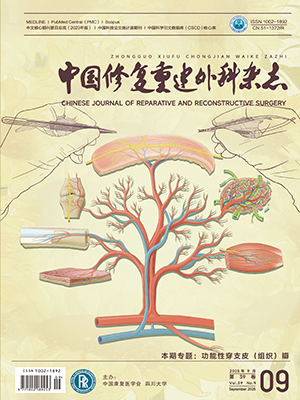Objective To investigate the possibility of repairing articular cartilage defects with the mesenchymal stem cells(MSCs) seeded type Ⅰ collagen-glycosaminoglycan(CG) matrices after being cultured with the chondrogenic differentiation medium. Methods The adherent population of MSCs from bone marrow of10 adult dogs were expanded in number to the 3rd passage. MSCs were seeded intothe dehydrothermal treatment (DHT) crosslinked CG matrices; 2×106 cells per 9mm diameter samples were taken. Chondrogenic differentiation was achieved by the induction media for 3 weeks. Cell contractility was evaluated by the measuement of the cell-mediated contraction of the CG matrices with time inculture.The in vitro formation of the cartilage was assessed by an assayemploying immunohistochemical identification of type Ⅱ collagen and by immunohistochemistry to demonstrate smooth muscle actin (SMA). The cells seededingCGs wereimplanted into cartilage defectsof canine knee joints. Twelve weeks after surgery, the dogs were sacrificed and results were observed. Results There was significant contraction of the MSCsseeded DHT crosslinked CG scaffolds cultured in the cartilage induction medium. After 21 days, the MSCseeded DHT crosslinked matrices were contracted to 64.4%±0.3%; histologically, the pores were found to be compressedandthe contraction coupled with the newly synthesized matrix, transforming the MSCsseeded CG matrix into a solid tissue in most areas. The type Ⅱ collagen staining was positive. The SMA staining was positive when these MSCs were seeded and the contracted CGs were implanted into the cartilage defects of the canine knee joints to repair the cartilage defects. The function of the knee joints recovered and the solid cartilaginous tissue filled the cartilage defects. Conclusion The results demonstrates that MSCs grown in the CG matrices can produce a solid cartilaginous tissuecontaining type Ⅱ collagen after being cultured with the chondrogenic differentiation medium and implanted into cartilage defects. We hypothesize that the following steps can be performed in the chondrogenic process: ①MSCs express SMA, resulting in matrix contraction, thus achieving a required cell density (allowing the cells to operate in a necessary society); ②Cells interact to form a type Ⅱ collagencontaining extracellular matrix (and cartilaginous tissue); ③Other factors, suchas an applied mechanical stress, may be required to form a mature cartilage with the normal architecture.
Citation: XIANG Zhou,HU Wei,KONG Qingquan,ZHOU Haitao,ZHANG Xihai. Preliminary Study of Mesenchymal Stem Cells-Seeded Type Ⅰ Collagen-Glycosaminoglycan Matrices for Cartilage Repair. Chinese Journal of Reparative and Reconstructive Surgery, 2006, 20(2): 148-154. doi: Copy
Copyright © the editorial department of Chinese Journal of Reparative and Reconstructive Surgery of West China Medical Publisher. All rights reserved




